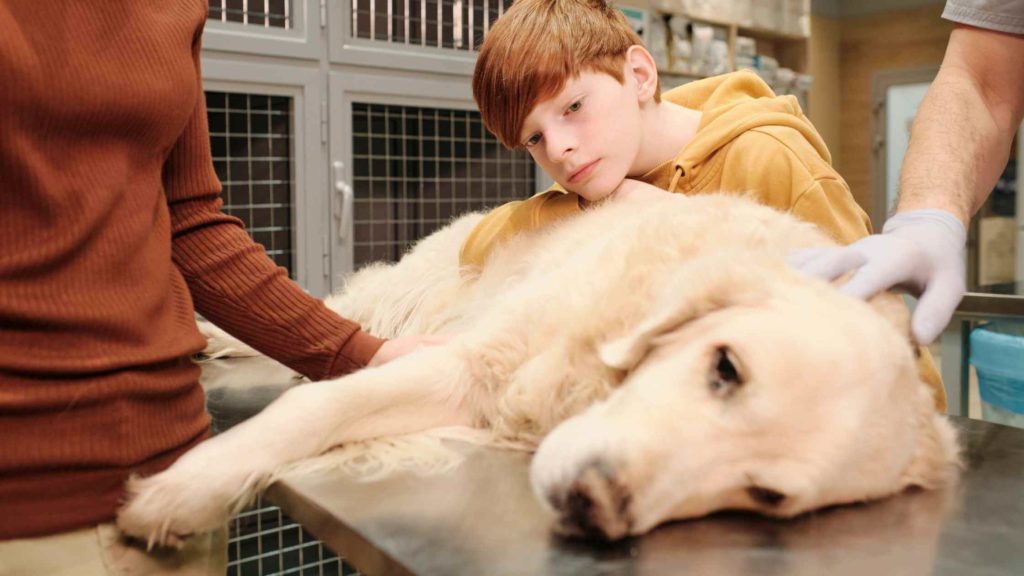
Every pet parent dreads this day and wishes it would never come. When it does, this is what you should know to help your dog pass as easily as possible.
Comforting a dying dog is about giving them as much comfort as possible, both physically and emotionally.
- Give him soft food and his favorite treats;
- Give him access to fresh, cold water, too;
- Put together a comfortable sleeping area with favorite blankets and/or their dog bed for ultimate cushioning;
- Put pee pads around them so that they don’t have to get up to use the bathroom if they are unable to;
- Keep the environment around them as quiet and as soothing as possible;
- Use soft tones when talking to them to keep them as calm and as fear-free as possible;
- Stay with your dog as much as possible.
How to comfort a dying dog at home
Even though dogs don’t fear death the same way humans do, most dogs are uncomfortable when they are nearing the end of their lives because their bodies are shutting down.
Adjusting your home as much as possible to minimize physical and emotional distress will make a significant difference in their final days and hours.
As introduced above, the key things you can focus on to comfort a dying dog include:
- Design a menu with all his favorite foods and treats;
- Give him access to fresh, cold water;
- Create a comfort-filled sleeping area;
- Have pee pads ready, so they can go as needed;
- Keep the environment as quiet and as stress-free as possible;
- Stay with them and keep them calm.
At this point in your dog’s life, it’s all about treating him to his favorites. Most dogs won’t have much of an appetite, so you’ll need to keep that in mind. But you can certainly give them palatable food that they’ll like.
For example, mix his regular kibble with a dog gravy or canned food for dogs. This is often a nice treat for them, incentivizing them to eat a bit more. You can also give him some treats and anything else that will help them enjoy something special.
Don’t feed him dangerous human foods since it can still cause him harm. Dealing with poisoning or complications of human food is not something that either one of you is going to want to deal with.
The point is to give him as many of his favorite, safe foods as possible. Nutrition won’t be as important since he’s on his last few days.
If your dog doesn’t want to eat, don’t force him to eat. Just make sure he has palatable foods available.
2. Give him access to fresh, cold water
If they don’t eat, many dogs will drink more water. You’ll want to keep their bowl of water fresh and cold. This will often offer them comfort with digestive issues and general physical comfort. Change your dog’s water frequently, at least twice a day!
3. Create a comfort-filled sleeping area
You’ll need to set up an area for your dog to, unfortunately, die in. This should be a space with many comforts — his favorite dog bed, soft blankets, and more.
It’s hard to face the idea that your dog will die in this area, but it will happen that way most of the time. Ensure that his space is as comfortable as possible since their joints and body can become sore and painful near the end.
If they have favorite pillows or blankets, use those. You can always replace them later. If he is comforted by certain toys, add those in, too! The goal is to pull out all the stops to pamper them.
4. Have pee pads ready so they can go as needed
Most dogs will lose control over their bladder and bowels at the end. This means that they’ll go to the bathroom without even knowing it.
This can often be distressing since they know they’re not supposed to go in the house, but either can’t feel themselves peeing or pooping or can’t control it.
Never chastise these behaviors in your dog. It’ll amp up their anxiety, which isn’t something they can control.
Quite often, dogs will vomit, too, often without warning. Having pee pads around them on all sides will help minimize any clean-up.
When they relieve themselves or vomit, clean it up right away and replace the pee pads with new ones. This will help ease your dog’s stress and keep their area clean and safe.
Reassure your dog as you do this so that they know that they’re not in trouble.
5. Keep the environment as quiet and as stress-free as possible
This is perhaps one of the most important things you can do for your dog in its final days. Their designated sleeping, eating, and living area should be calm and quiet.
Your dog will be sleeping a lot, and they’ll be in pain or at least uncomfortable. Keep this space as calming and soothing as possible.
This includes keeping kids and other pets away, too. Not only do both tend to poke and prod at your dog, who isn’t going to enjoy that, but they can also often be noisy.
You can allow kids and other pets access to your dog if they bring him comfort, but you’ll want to keep the visits supervised in case they overwhelm your dying dog.
In some cases, your usually friendly dog might turn aggressive. They might snap at pets or kids that mean them well, or even at you.
Dogs know when they are injured and need to “hide” while they heal because they’re vulnerable. Their ancestral brain then makes them snap at those who could “harm” them while they are in the process of healing. Dogs don’t understand that they are dying, so they’ll simply protect themselves until they feel better.
As scary as it might be to see your dog snapping at everyone, don’t chastise them. This is a biological impulse, and they can’t control it.
Reassure them that they are okay and monitor visits from the kids and other pets. If they growl when touched, don’t touch them. Respect their space, but stay close by so they know they aren’t alone.
6. Stay with them and keep them calm
Another essential detail to help comfort your dying dog is to stay with them as much as possible and keep them calm. Even though they don’t fear or understand death, they will be feeling unwell, which can stress them out.
Ease their stress by staying close and offering cuddles and snuggles if your dog wants them. Use a soft voice and a soothing tone when you speak to them. Your dog will interpret this as a reminder that they don’t need to be fearful because you are there with them and protect them.
When you have other family members and kids coming to visit, do your best to make sure that they are calm and soothing, too. While some crying and anxiety are normal, it’s best to minimize that around your dog. These can distress your dog, after all.

How do I tell my dog goodbye?
The hardest part, of course, is telling your dog goodbye. It is, without a doubt, the most challenging moment for pet parents.
The process will be personalized to your relationship with your dog, of course, so it’s going to look a little different for everyone.
Here are some general tips to help you know what to do.
Firstly, you’ll need to accept that, as much as you don’t want to face it, the moment has come. You have to be strong and be there for your dog so that you can say goodbye properly.
Dragging it out can cause your dog more physical and emotional distress. Accept the moment for what it is and prepare yourself.
Next, you’ll want to tell him goodbye by reassuring them that they’re a good dog — the best dog — and that they are safe and loved.
You can do this by giving them lots of hugs, ear scratches, and pets. Keep your tone as calm as possible, though it’s normal to tear up a bit.
Keep doing this as your dog passes. It will be the best ending they can have since they won’t have to be fearful since you are right there and being so reassuring.
How do I give my dog a peaceful death?
Sometimes dogs will pass overnight in their sleep. While understandably distressing for their owners, it can be a peaceful death for dogs since they are unaware.
If your dog is in pain and you want to end their suffering, your best choice is euthanasia.
This humane method combines a strong sedative with a heart-stopping medication. The sedative sends them into a deep slumber that takes away their pain and fills them full of endorphins (aka bliss).
Since this is a potent dose of a sedative, it will make most dogs fall deeply asleep. This makes them unaware of the passing, reassuring us that they will never know what death feels like.
The second shot is called barbiturate, and this is a drug that will stop the heart and lungs. This is technically an overdose. The sedative is given first to ensure that your dog doesn’t feel either process, which can panic them.
You can consider euthanasia at a clinic or home, depending on your dog’s health and comfort and your preference.
Should you be with your dog when they are put to sleep?
Most, if not all, pet parents will find watching their pet die very distressing. Many will choose not to be there and allow the vet to do it independently.
Deciding to be there or not is certainly a personal decision that you’ll want to think about carefully.
If you can manage it, it’s best to be there for your dog when they are put to sleep. The reason is that they can become scared or uncertain if they are suddenly with a strange person and you are gone. Since you are often visibly upset as you leave, this can further distress your dog.
Be there with your dog until they pass and pet them, talk to them and hug them. It’s okay to be upset and crying since the sedative will make your dog unaware of it. Your vet will take care of the medical process, so all you will need to focus on is your dog’s final moments.
In Short
When your dog is dying, you’ll need to provide them with as much comfort as possible.
This includes physical comforts such as bedding and toys. It also includes emotional comforts such as a peaceful environment and lots of love from you and your other family members.
You’ll want to consider euthanasia to help ease their passing, if at all possible.
Comforting your dying dog is an exercise of trust, love, and managing emotions. It is inevitably the most challenging part of having a beloved dog in your family, but an essential part of your life together know about.
Know someone facing this difficult time? Share this with them to help make it a bit easier.
